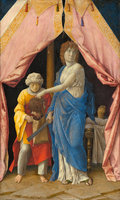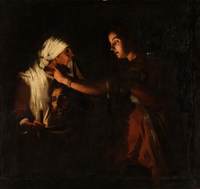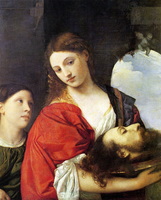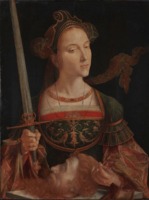Late 15th to Early 16th Century
Two women, Judith and her maidservant, stand at the opening of a tent, the pink and gold of the opened drapery revealing a glimpse at the sleeping body of Holofernes. Judith is depicted with a head of auburn ringlets, wearing a white underdress with blue drapery sensually falling off of her left shoulder. In her left hand she holds the severed head of Holofernes by his brown hair, in her right is his sword she used to commit the act. Her gaze is turned aways as she places the head into the burlap sack offered to her by her maidservant—an elderly woman wearing a tunic of bright red and yellow fabrics, her head modestly wrapped in a white headwrap.
Mantegna portrays Judith as though she were a classical statue. The folds of her white gown cling to her as if wet, falling in a sculptural form, just as the fabric of the tent, and she is twisted into a contrapposto stance—just as in Renaissance figures. She is serene and calm, unbothered even, as she dismissively goes to drop the severed head into the vessel offered to her by her maidservant.
Born in Padua, Italy ca. 1431-1506, Mantegna was strongly influenced by his father-in-law, Italian painter Giovanni Bellini, as well as Florentine sculptor Donatello; Donatello, himself, also contributed a sculptural rendition of Judith beheading Holofernes.
A scene lit exclusively by a single candle, Judith and her maidservant emerge from the shadows. Judith is depicted with a head of ebony hair so dark it appears to disappear into the background, wearing a dark red gown with gold trim and a brown shawl. She is wearing a pearl bracelet on her left wrist, the hand of which the severed head of Holofernes is held. Holofernes' head sees him as an older man with long brown hair and a beard, pallid lips slightly agape, eyes droopy and lifeless. The face is illuminated by a candle held in the right hand of her maidservant, the left of which presumably holds the burlap sack Judith is placing the head into. She is an elderly woman wearing a white headwrap and modest garments, looking away from the gruesome thing before her as her mistress stoically looks on.
Born in Mechelen, Belgium ca. 1586, Adam de Coster specialized in night scenes characteristic of chiaroscuro, the scenes often lit exclusively by candlelight, a quality typical of Caravaggio's followers (also known as the tenebrist style). The grisliness of the story coupled with the calculated use of lighting makes this interpretation of Judith beheading Holofernes comparable to Caravaggio's 16th century rendition.
Judith stands before a brick wall set before an idyllic, pastoral landscape. Her auburn hair is neatly pulled away from her face save for loose tendrils framed her youthful face. Adorning her head is a hair piece with a gem similar to that which embellishes her pink dress. The dress modestly covers her figure, save for a long slit that runs up and reveals her left leg. Her expression is thoughtful, downcast toward her foot which is bare and perched atop the severed head of Holofernes whose skin yellowed and cheeks sunken. She stabilizes herself by shifting her weight onto her right side, further supporting herself with Holofernes' sword.
Giorgone was born the year 1478 in Castelfranco, Italy. This painting of his appears similar to Mantegna's, and presents us with a statuesque Judith. The drapery of her garments rest as if in sculptural form, her body in a soft contrapposto akin to the Venus de Milo. Her face is stoic in true classical style, features comparable to da Vinci's Mona Lisa. The calmness of Judith herself and the still tranquility of the morning landscape create an ambience of poetic thoughtfulness, undisturbed by even the severed head of Holofernes—a world in perfect harmony.
Despite the historical subject, this painting is an example of a poesie, a type of work created by Giorgone himself and soon widespread in early 16th-century Venetian painting. In fact, Giorgone's work largely influenced the development of 16th century Venetian painting, influencing artist's like Titian's interpretation of the biblical story as well.
Judith and her maidservant stand in a stone room, there is a window on the right which Judith stands before, revealing a blue sky. She is a fair woman, auburn hair pulled away from her face save for a few stray curls. She is wearing a luxurious gown that has puffy red and white sleeves with white and gold trimming, a blue cloth draped over her left shoulder. Her head, parallel to a cherub figure in the upper left corner, is turned away, eyes downturned toward the severed head of Holofernes. The head rests on top of the gold platter in her arms, eyes closed and shows Holofernes as a man with sunken cheeks, curly long brown hair, and a beard. As Judith angles her head and gaze away from the head, her maidservant is stood on her right, looking up at her in admiration.
It was long thought that this painting depicted not Judith with the head of Holofernes, but rather, another biblical decapitation—Salome with the head of St. John the Baptist, thus why many have referred to it as Salome. However, the main figure has been considered too tempting to be anyone other than the beautiful widow from Bethulia.
Titian was born 1490 in Pieve di Cadore, Italy. Some originally attributed this painting to Giorgone rather than Titian, who's earlier painting of Judith and Holofernes undoubtedly influenced Titian. However, the distinct use of vibrant color (particularly his focus on the effect of light on color) and line (the Venetian Renaissance style was defined by vibrant color and led by Titian) is what distinguishes the two artists.
Judith looks off to her left. She is wearing a deep, emerald green gown with red accents, an intricate gem necklace at her throat, her red hair braided and held back by an elaborate headpiece, the outline of her braid blowing in the wind. In her right hand she holds Holofernes' sword, and in her left she is twirling the auburn hair of his severed head; coupled with her far-off gaze, suggests that she is contemplative, deeply immersed in her thoughts.
Born 1500 in Haarlem, Netherlands, Vermeyen presents us with an image that is dramatically assertive, Judith dressed as a classical heroine in antique, pseudo-Roman armor. He was a painter and tapestry designer, influences of the latter seen here in the swirling details both on on her gown and of her headpiece. He depicts her with large, masculine-looking hands, brazenly wielding the sword she has just used to sever the head of the Assyrian general. She is absorbed in thought, relishing in her triumph over the Assyrians.




